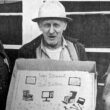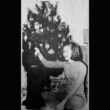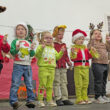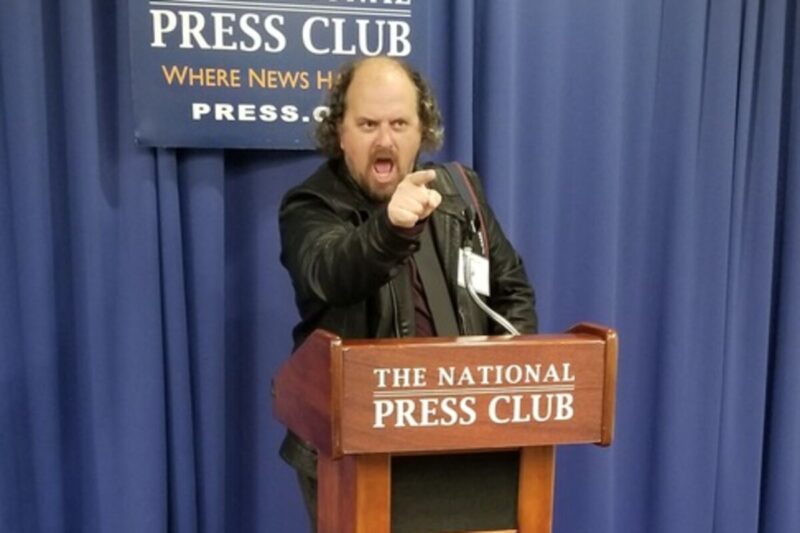Sean C. Morgan
We woke to the sounds of sirens.
Step out of the house for a quick vape, and there’s that sound. Again, no police cars, just ambulances and fire engines – all day long, everywhere in this town.
Continuing my stint as an embedded reporter with the city contingent to Washington, D.C., I’d like to note that the city manager, Ray Towry, is dedicated to the humdrum and mundane in a time and place that share neither of those qualities. He stayed behind first thing in the morning Monday to work on next Tuesday night’s City Council agenda and packet.
As City Councilor Dave Trask puts it: boring.
My wife Tiffany and I headed out with Trask and Mayor Greg Mahler to take in the landmarks and monuments around the Capitol Mall. After a short ride with an affable Uber driver, who endured Trask’s wisecracking, we jumped out at the Washington Monument.
We wanted to take the trip to the top, but the landmark is closed to modernize the elevator on a $2 million to $3 million donation by David Rubenstein. He had already donated $7.5 million repairing the monument after a 2011 earthquake.
We took our photos and walked to the north, toward something called “The Ellipse,” where another important Christmas tree, the National Christmas Tree, was located with the White House as a backdrop. It is surrounded by a small Christmas tree from each state. Students at the Howard Street Charter School in Salem made the decorations, featuring scenes and symbols of Oregon, for the tree.
Of course, that’s not really anything when you look up and see the White House itself. I lived outside of Baltimore when my dad was stationed at Ft. Meade in the 1970s. I saw all kinds of Washington, D.C., things when I was a small child. Field trips to Ft. McHenry and Mt. Vernon were common – and it was something to see the flag from Ft. McHenry hanging in the Smithsonian.
But I never saw the White House.
It’s separated from the masses by a number of fences, a road that no real people are allowed to use and a bunch of police officers from one of Washington, D.C.’s 40,000 law enforcement agencies, the Secret Service in this case, each wearing a vest marked “police.”
“How many days in jail do I get if I hop over the fence?” Trask asked.
“Too many,” the officer replied without batting an eye.
“One is too many,” Trask said, so he thanked the officer for his service, and we moved on.
Around the corner, Trask and Mahler zeroed in on a street vendor selling all the tourist trap D.C. stuff you could ever want at far too high a price – just like Disneyland. They picked up their 2020 Make America Great Again hats, and I’m glad they did. Believe it or not, those MAGA hats came in handy later. Apparently, they come with a special privilege.
We moved on to the World War II Memorial, Lincoln Memorial and then the Vietnam War Memorial, where we located the names of two Sweet Home men who died serving in Vietnam: John William Carper Jr., who died July 3, 1970, and Harley Daniel Dimick, who died on May 24, 1969. Trask attended high school with Carper.
We also located the name of Mahler’s cousin: William James Griffin, who was shot down on March 14, 1969. Tragically, his infant daughter died four months later from sudden infant death syndrome.
“May you rest, buddy,” Mahler said as he laid his hand over his cousin’s name.
We paid our respects and moved on to the Korean War Memorial and then east, back toward the Washington Monument along Independence Avenue. Here’s the thing about that, it bends away to the north, but a path kind of carries you along the street until you encounter at 17th Street. But there’s no crosswalk.
To use the crosswalk, you’ve got to walk to the north along 17th. That’s where those MAGA hats came in handy. Tiffany is a rule-follower. She never drives over the speed limit, or at least never more than 5 mph if she’s not paying attention.
She crosses streets at the crosswalk – always.
And then there’s me. And Trask, who while once gainfully employed, was paid the compliment of a reprimand in his personnel file.
“I had trouble with authority figures,” Trask said. “If you think I would get upset about that, you’d be silly. I would not.”
Tiffany really wanted to use that crosswalk, but we couldn’t bother.
“We’re breaking the rules,” Tiffany protested, but Mahler solved the problem with the obvious answer.
“We’re OK,” he said. “We have Trump hats on.”
The Thomas Jefferson Memorial was visible in the distance off to the right, the World War II Memorial to the left and the Washington Monument in front to the left as we crossed the street. We soon reached the intersection of 14th and Independence, where the point of our whole visit, the U.S. Department of Agriculture and the U.S. Forest Service, is headquartered. Next door was the U.S. Holocaust Memorial Museum.
Walk into the latter building, and it’s instant silence. The noise from the streets, the sirens, all of it, just fade away. That’s before you even enter the exhibit.
To begin the tour, visitors take a miniature from two stacks flanking an elevator. Inside the file, is the name and information about a Holocaust victim. Each file is different.
Visitors enter the elevator, which moves up three floors. A video inside the elevator sets the stage for the Holocaust. The elevator doors open to reveal a pile of corpses burned by the barbaric, murderous Nazis.
From there, it’s a slow, somber walk. The exhibit is utterly quiet, broken in the distance by the chanting and singing of Nazi soldiers and Germans. Each step is seemingly more horrific as the enormity of killing 6 million Jews and millions more dissidents, homosexuals, Gypsies and others reveals itself.
The Nazi’s Final Solution to the “Jewish Question,” is illustrated in an unpainted, white 3D model of the Auschwitz concentration camp. It depicts Jews as they are ordered to remove their clothing for a mass shower and moved into a killing chamber where they are gassed. A few were kept alive temporarily to process the victims, take their gold fillings, cut their hair for use in German products and then to incinerate the corpses.
Visitors are exposed to the horrors faced by the Jews, a train car that might have carried a hundred Jews to death camps, the bunks that housed seven or eight Jews at a time. Piles of shoes illustrates what remains of those murdered by the Nazis. Visitors walk on the same cobblestones used by Polish Jews in a “ghetto.”
The taste of this appalling chapter in human history is difficult yet nothing in context of those who directly faced the cruelty of the Nazis. It is meant to remind us – Never Again. It honors those who ended the Final Solution and the Nazi Party, the Allied soldiers and the soldiers of the United States.
But this is Christmas! We needed to do some Christmas things.
We attended a Capitol Christmas tree partnership reception at the National Press Club, where Chuck Leavell, keyboardist for the Rolling Stones, Eric Clapton and the Allman Brothers, sang “Hey, Santa (What’s in the Bag for Me?)”
That got us in the festive mood as Choose Outdoors, a nonprofit partner to the U.S. Forest Service in this Capitol Christmas Tree experience, presented awards to various partners who helped bring the Sweet Home Ranger District’s noble fir to Washington, D.C. An excellence award went to the Willamette National Forest team.
That festival we had at home felt a lot like Christmas, the best Christmas festival we’ve ever had in Sweet Home, really – a month ago, before Thanksgiving.
Washington, D.C. is busy. There’s a lot to do that has little to do with Christmas. It’s a bustling place filled with people who are busy trying to find new ways to monitor, control and mess with your lives, a place almost all of us hate in some way on one hand and cannot help but love on the other hand. But it’s not Christmas.
Not until that little fourth-grader, Bridgette Harrington of Hillsboro, gets up and reads her poem or sings. She performed “Christmas is a Feeling,” and instantly, the room was Christmas! She did it again the next morning when she recited the poem that made Gov. Kate Brown pick her to light the Capitol Christmas tree Thursday. Singing and playing the violin, she deservedly earned a standing ovation from the partners.
After that joyous evening, we knew President George H.W. Bush was lying in state inside the Capitol rotunda. The wife was tired and needed to call it a day, so Trask, Mahler and I parted ways with her and Towry and walked to the U.S. Capitol building from the National Press Club.
Along the way, some flavor of the police had road after road closed. We passed the Trump International Hotel, where I took a photo of Trask and Mahler, who had ditched their 2020 MAGA hats earlier in the evening.
We continued on as numerous police motorcycles began passing us by, coming up Pennsylvania Avenue from the Capitol. Mahler said it must be a dignitary. No sooner was that out of his mouth than the limo appeared followed by that odd black vehicle. They were the only two vehicles not running red and blue lights.
What looked a lot like President Trump was visible through the window in the back of the limo. After passing by, an officer admitted that it was the president, but he wasn’t supposed to tell anyone before or after who it was.
As we neared the Capitol, Trask nearly went for a ride on a stray skateboard that rolled his way, and then we entered the U.S. Capitol to pay our respects to the first President Bush.
It was another appropriately somber moment in our Christmas trip as we observed a member of each of the five branches of the U.S. Military standing guard over President Bush’s casket, thousands of visitors solemnly and silently moved through the Capitol Rotunda, some praying and performing the sign of the cross, others quietly observing.
“Sense of loss,” Mahler said about it. “I thought he was a good man. I thought his service and sacrifice to this country is well-deserving of respect and for all citizens to pay their respects to him. You’ve got to take the political side out of things and what the overall accomplishments are. You look at his past history and it’s just amazing. He nearly lost his life in World War II.
“Sense of awe. That’s something you don’t see in your lifetime anyways. A sense of loss, personal loss myself, (losing) somebody that represented your country (that way), who devoted his life to public service. You’ve got to respect that, his overall commitment to the country.”





